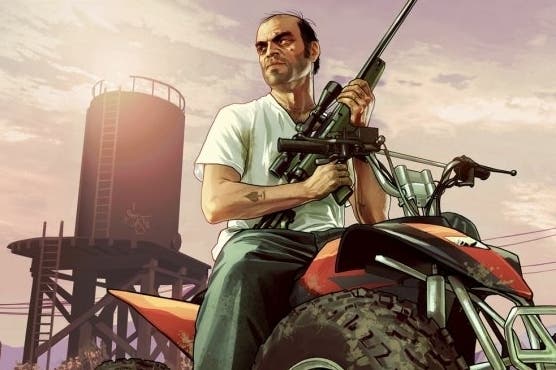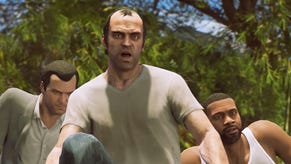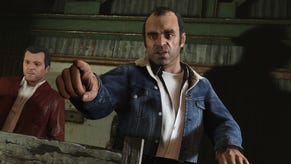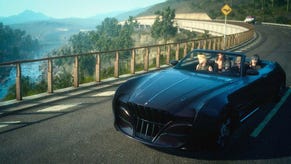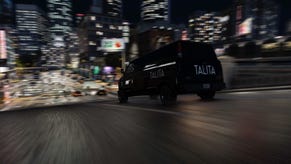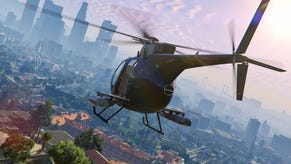Face-Off: Grand Theft Auto 5
Rematch.
| Xbox 360 | PlayStation 3 | |
|---|---|---|
| Disc Size | Disc One: 7.7GB, Disc Two: 7.8GB | 17.4GB |
| Install | 7876MB (mandatory) | 8486MB (mandatory) |
| Surround Support | Dolby Digital | Dolby Digital, 5.1 LPCM |
Never a series short on ambition, Grand Theft Auto's latest instalment brings to life one of the most beautiful and lavishly detailed sandbox worlds of the current generation. Long-time readers will recall that GTA 4 represented a similar milestone moment in the showdown between PS3 and 360 back in 2008, with each version handling the newly-forged RAGE engine with unique visual trade-offs and Microsoft's platform taking a lead in the performance stakes. Five years on it's high tide for round two: the core engine work has seen great upheaval and the 49 virtual square miles of game world are impeccably presented on both platforms. Once again though there are key advantages to either side.
At its heart, RAGE is comprised of mostly in-house developed parts, from the animation engine and rendering framework to a bespoke scripting language - allowing developer Rockstar North to custom-tailor unique events for missions, and even design mini-games such as golf and tennis. But its core strength, stemming back to earlier iterations on PS2, is its ability to stream assets such as textures, buildings and oncoming vehicles seamlessly on memory-limited hardware. Level-of-detail scaling is used subtly, and in the case of thick, urban sprawls, skyscrapers act as occluders to allow culling of unseen geometry. Given the tight memory budgets of the PS3 and 360, tricks like these are crucial for keeping the game running at a fair clip, and to avoid abrupt pop-in.
For PS3 in particular, the technology has come a long way in harnessing the console's notoriously finicky split-pool setup for RAM. The limitation evidently proved to be a roadblock for budgeting on the video memory side with GTA4, where the decision was made to render at a native resolution of 1152x640 - a 20 per cent cut-down compared to the Microsoft release. Thankfully this has now been addressed, and for the latest entry the PS3 version matches the 360's full 1280x720 framebuffer. It looks gloriously clear, and image quality is now identical down to the pixel.
For a close inspection of how the two versions match up elsewhere, we've produced a 130-strong comparison gallery, plus a meaty head-to-head video above. Thankfully Grand Theft Auto 5 synchronises the time of day before each major mission in a timelapse-style speed-up, though as always we're at the mercy of the game's simulated weather and randomised car placement.
It's clear that, while each version of GTA 4 offered a different look that befitted the technical limitations of each platform, now we have two versions that look very close indeed. The expensive 2x multi-sample anti-aliasing used on 360 is now gone, and so too is the PS3's forceful blur filter - both releases now opting for a refined post-processing approach. The resulting image is minimal on blur, and very reminiscent of Rockstar's Max Payne 3, covering all details such as geometry and alpha transparencies at minimal expense to tackle jagged edges. Dropping the Vaseline blur on PS3 stands as an especially big coup d'etat for image quality purists - something recognised by Rockstar itself during development of The Ballad of Gay Tony expansion, where it was axed outright. Similarly, we're pleased to see the 360's distinctive dithering artifacting has disappeared.
But, as with most late-generation Face-Offs, the best way to put differences into context is to start with the assumption that everything is otherwise the same. For Grand Theft Auto 5 this is very much the case - and overlooking some nitpicks, just about every single geometric detail and effect across Los Santos is like-for-like between PS3 and 360. However, there is one glaring contrast throughout our tests that can't be ignored.
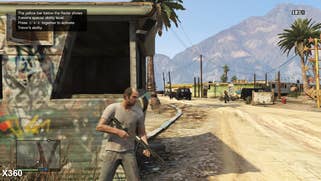

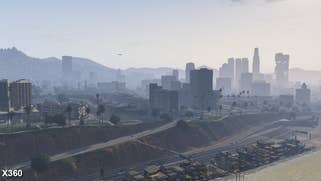



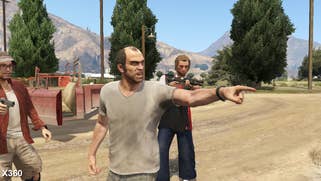
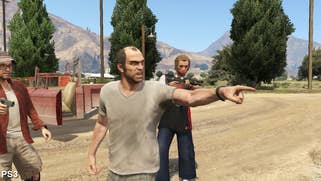
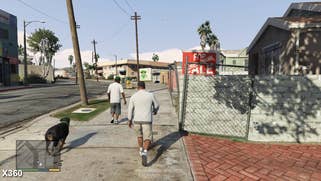
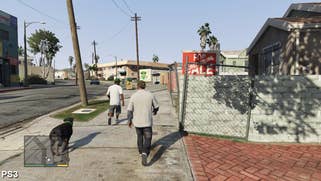
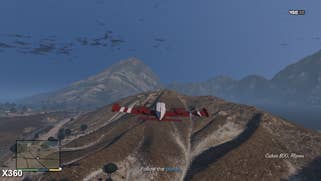
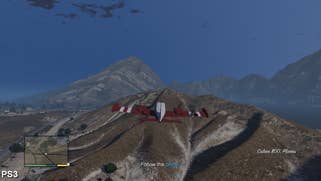
Despite each console's mandatory installs - 7.8GB for 360 via a separate disc and 8.4GB on PS3 - it quickly becomes clear that there's an asset-streaming issue on Microsoft's platform. This essentially manifests as blurrier textures in a number of spots, particularly for ground assets like concrete, grass and dirt. Whether you're at the city centre or in the wilderness, ground assets beneath Trevor, Michael or Franklin's feet are a pixel-perfect match for the PS3 version equivalent, but the quality dips off noticeably a metre ahead in the player's field of view on 360.
Normally we'd put this down to inferior texture filtering, but it's often the case that higher-grade ground textures never pop in during certain cut-scenes either. Best shown in the very first clip in the video, based around the O'Neill brothers' farm, the flatness of these surfaces is severe enough to prompt a retrial with two other 360s we had available. However, in every case the PS3 turns up trumps with sharper textures, proving it's not the fault of a single borked console - this is the reality for all 360 owners.
This leads to a second salient point regarding the 360 release. As it transpires, while a disc one install to the HDD is absolutely mandatory, it is also possible to install disc two - used to boot and play the game from then onwards - optionally from the Xbox dashboard. We'd advise avoiding this tactic if possible, as does Rockstar itself, despite the obvious benefits of quietening older 360s during play and saving on general wear-and-tear to the optical drive. In our experience, it increases the frequency of geometry and texture pop-in during quickly-cut cinematics, such as the pier-side railings and Ferris wheel that feature in the game's opening montage - just two examples among many. We have tried installing the play disc to a USB flash drive though and this does seem to resolve the issue.
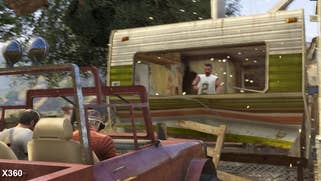


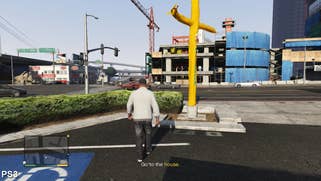

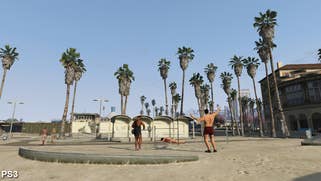

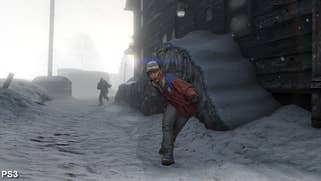
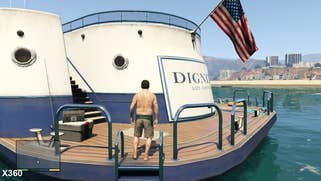
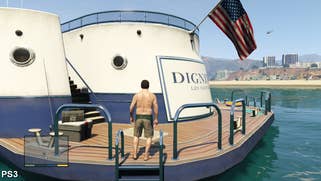
Simply put, having both discs installed to the 360's HDD appears to create a bottleneck for the engine as it attempts to draw these assets from the same source, but playing straight from disc gives us comparable results to PS3. This hampers the experience much more than the launch issues Skyrim had, where that game suffered from similar texture-streaming when installed. In this case, the engine is apparently optimised to utilise bandwidth from both the disc drive and HDD at once.
Running straight from disc, then, there's little to distinguish the PS3 and 360 releases when it comes to object detail, but there are some curious catches. Flying the Cuban 800 plane around shows up variations in grass placement, but more striking is the presentation of palm trees regularly sighted around the city. Their more flourishing look on 360 is unusual given the parity elsewhere, though we notice the upshot of this is a nasty pixel-crawl across their tops during slow pans, suggesting alpha-to-coverage dithering in concert with the post-AA producing the unwanted effect [Updated: corrected]. Also falling within nitpick territory is a slight difference to reflection map resolution while in front of Franklin's bedroom mirror - the PS3 delivering a lower-quality, pixellated alternative to the 360's reflections.
On the effects side, full-screen motion blur is considerably toned down from its implementation in Grand Theft Auto 4, which was previously set off by switching rapidly between targets while in combat mode or speeding across draw-bridges at full throttle. For this latest entry, motion blur appears disabled for the general run of play, likely to save on performance, though it is occasionally used during cinematic scripted events - such as ramming a rival drug-dealer's caravan into a river. Depth-of-field (DOF) is also now less aggressive, with a bokeh effect coming into play at night as we view the city lights at a distance from the mountainsides.




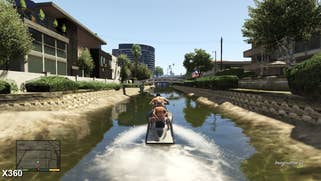
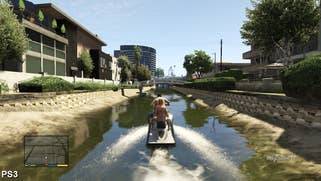
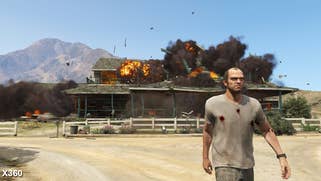
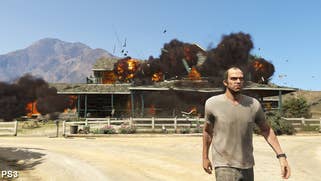
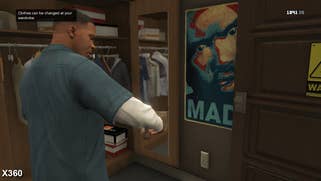
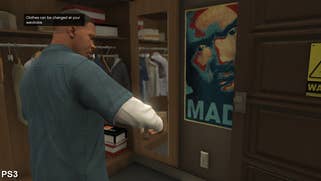
Arguably the biggest engine enhancement comes by way of the handling of lighting and shadows on console, which now adds improved lens flare effects and light shafts. Most outdoors lighting is entirely dynamic as expected of the series, being based on the state of the day-night cycle, and weather effects such as lightning. At low angles, the dithered, speckled shadows that blighted the look of Liberty City in the previous game are replaced with a fuller, richer alternative with minimal flicker on movement. Sadly, shadows produced from thin objects look a coarse when up close, and there's a simple filtering cascade that switches quality quite visibly as we run forward. However, there's no denying that this is a massive step up from what we've seen before.
Physics also play a huge role in bringing Grand Theft Auto 5's world to life. Together with the studio's built-in physics engine for cloth and water simulation, third-party solutions named Bullet and Euphoria are also employed to generate realistic and unscripted body animations on impact, plus environmental destruction on small walls and vegetation. Depending on the angle and momentum of oncoming traffic, a collision will send the leading character spinning and flailing to the ground in an unlimited number of cringe-worthy ways - this processor taxing logic holding true for both versions of the game.
Grand Theft Auto 5: performance analysis
With some of the most exemplary lighting, effects and physics to be used in an open-world game, our expectations have to be managed carefully when it comes to the sobering issue of frame-rates. It's difficult to forget the 20fps response of some passages of play in Grand Theft Auto 4, particularly on the PS3 side when confronted with a cluster of skyscrapers gridlocked by cars. The game's complex pipeline also resulted in some of the worst input lag on record in recent times, with anything up to a 200ms response when tested with a Ben Heck latency controller monitor board.
"In like-for-like scenes we often see a 360 performance lead, but its in-game the impact is far less pronounced than it was in GTA4."
But with the RAGE engine being iterated upon in recent years following its uses in Red Dead Redemption and Max Payne 3, that frame-rate gap has indeed narrowed. The abandonment of a dense urban jungle setting like Liberty City in favour of a more open sprawl does alleviate some of these demands and opens up a broader draw distance overall - mirroring the transition from Grand Theft Auto 3 to San Andreas on PS2. It's also fair to say that input latency is vastly improved this time around, where the level of response is perceptibly like-for-like between the 360 and PS3 versions and the overall sluggishness of play is greatly diminished.
The target this time is 30fps for both platforms, and it holds at that point for most areas. Overall the PS3 puts out the lower frame-rate for synchronised in-engine cut-scenes, typically by a matter of two frames-per-second and rarely much more. Curiously, the 360 version is the only one of the two to drive upwards from the 30fps target on occasion - far from being ideal, this produces a judder effect due to the frame-rate no longer operating as a multiple of the 60Hz output signal. Regardless, the readings for both consoles stick together like glue during dips below the line, with each going as low as 20fps.
For unsynchronised play involving cop chases through busier segments of the city, it's common to see drops to 20fps on both platforms as well, though a clear performance leader is hard to parse out here. Trevor's more explosive battles with rival drug dealers in the outback areas also suffer, during which the PS3 seemingly takes an advantage despite the chaotic excess of fire and smokes effects. Ultimately, the variability of this lead shows attention has been duly paid to the strengths of the PS3 architecture, where the difference is practically imperceptible to the naked eye.
"It's fair to say that the 360's performance advantage has less impact in-game compared to its texture filtering issues. It's close, but PlayStation 3 is our preferred platform for this game."
Grand Theft Auto 5: the Digital Foundry verdict
At last, Rockstar North's monstrous open-world caper is here in all its glory - but after five years and an estimated £170 million being sunk into development and marketing, which version is the one to buy? After playing both versions extensively and amassing over 2TB of lossless video to analyse, we must stress that you're bound to have a fantastic time with either take. Lighting and physics engines are fully intact on both versions, and the minor differences in reflection mapping go down as nitpicks. At its core, both PS3 and 360 present the same massive Los Angeles-inspired sprawl via the same 720p native resolution lens, with almost entirely identical effects and object detail.
However, it's apparent that the PS3 version has an undeniable advantage in one area: even to the naked eye, ground textures on 360 are blurred as a result of what appears to be unoptimised asset streaming. Glitch or not, this basically amounts to concrete and grass textures appearing fuzzier beneath the feet of Trevor, Michael or Franklin, while the PS3 version's remain crystal clear. The 360 does command a minor advantage in frame-rate during synchronised play, but for shoot-outs and high-speed hurtles down the city streets, the PS3 can sometimes pull ahead in these metrics - though the difference is rarely perceptible either way. Since all else is identical across the board, the PS3 version is recommended on the grounds of image quality if you have the option.
Grand Theft Auto 5 easily counts as the most feature-rich and eye-catching sandbox title of the current generation to our minds, though the silence on the as-yet unannounced PC and next-gen releases is deafening. Adaptations must surely be in the running - and doubtless these would be bolstered by smoother performance and higher-grade effects afforded by more muscular hardware. But that's perhaps missing the point; with so much heist-plotting content crammed into one package, and with an intriguing 16-player online mode yet to be patched in, there's no time like the present to enjoy Los Santos' delights on the platforms you already own.
